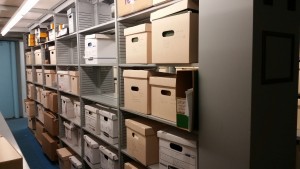My name is Kathleen Carter and I’m a recent graduate with a Master’s of Science in Library and Information Science from Simmons College in Boston, Massachusetts. I moved to Austin to begin work as the Processing Archivist for the Anthony Alofsin Collection for the Alexander Architectural Archives. The position was generously funded by Dr. Alofsin along with the donation of his papers. Since the end of July, I’ve been processing the collection of the University of Texas at Austin professor, award-winning architect, author, exhibit curator, and expert on modern architecture.
If Dr. Alofsin seems like a man who wears many hats, the Archive of his materials certainly verifies that. A major part of the Alofsin Archive is his personal library, now housed in Special Collections of the Architecture and Planning Library. The collection of books, academic journals, and other publications varies from several volumes on architect Frank Lloyd Wright (Dr. Alofsin is a leading authority on Wright) to art books to collections of Irish ghost stories.

This wide array of interests and professional work comes through in every part of the collection, and has made it interesting to work with. The approximately 57 linear feet of archival material follows Alofsin’s personal and professional life from his days as a master’s candidate at the Harvard Graduate School of Design to the intensive research accumulated for several of his publications. Over his thirty-year career, Alofsin has published a dozen books, founded The University of Texas at Austin’s Ph.D. in Architecture, and kept up a professional practice as an architect (including designing his own home). Alofsin has also, as the creator of the collection and therefore the preeminent expert on its contents, proven to be an invaluable resource himself. His office in the School of Architecture is a few minutes’ walk from where I’m working on his materials. Meeting with him has provided me otherwise impossible insight into the collection.

While completing the detailed inventory of the collection, I found Alofsin’s drawings, both his student work for Harvard and for his professional practice, some of the most visually stunning parts of the collection. For his final project at Harvard, Alofsin created a design for a new Boston City Hall. For another student project, Alofsin visited Jerusalem in 1980. The collection includes drawings and several 35mm slides of the Jerusalem Gates that he took on the trip. Later work includes drawings and plans for an addition to a historic home in Santa Fe, New Mexico and the plans for his own Austin, Texas home.

Other highlights of the collection include his work as a professor. The complete lectures and slides for Alofsin’s Survey courses on the history of modern architecture make up a substantial part of the collection. These allow for the study of courses which no longer exist and include an abundance of stunning visual material. Many photographic materials also exist for the body of research that Alofsin completed on Central European Architecture. Photos of beautiful architecture in Vienna, Prague, and Budapest used in Alofsin’s book When Buildings Speak: Architecture as Language in the Habsburg Empire and Its Aftermath, 1867-1933 fill several folders of the collection. Carefully rehousing all of these photos to preserve them for future research will make up the next large part of the project.
Along with rehousing and description, I will also create a complete archival finding aid of the materials. The finding aid will be available online and the collection open to researchers, allowing for the discovery of the wealth of information available within the Anthony Alofsin Archive.
